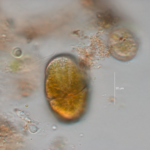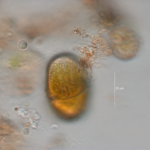Detected Species
-
HAB Species
- Diatoms
- Dinoflagellates
- Cyanobacteria
- Raphidophytes
- Haptophytes
-
Non-toxic Species
- Diatoms
- Dinoflagellates
Contact Us:
Mihaela D. Enache, Ph.D., Project Manager & Co-PI, Research Scientist I, Division of Science and Research, NJDEP (mihaela.enache@dep.nj.gov)
Ling Ren, Ph.D., PI, Research Assistant Professor, College of Science, George Mason University (lren2@gmu.edu)
Levanderina fissa
Syn. Gyrodinium uncatenum
Morphology
Cells large, about 30-50 μm in length, 20-40 μm in width, and 20-30 μm thick. Cells ovoid in shape, slightly dorso- ventrally compressed. Epicone rounded or truncated, hypocone bilobed, cingulum excavated, narrow and displaced 1/2-1/3 of the body length, chloroplasts yellow-green to yellow-brown and appear radiating, nucleus spherical and located in the epicone.
Toxins and toxicity
The species is not a toxin producer. However, its blooms were related to fish and shrimp kills (Steidinger 2018). The species is also noted as a causative organism of paralytic shellfish poisoning (Hallegraeff et al., 2010)
Distribution and Occurrence
Europe (Baltic, France, Portugal), North America (Maryland, Texas), Asia (China, Taiwan). In this study, L. fissa blooms were observed in several SMPs, including REF-1. PGD-1, PGD-2, and OMWM-2 in the months from June to August.
References
Steidinger, K.A. 2018. Chapter III. Toxic and potentially harmful dinoflagellates in the Gulf of Mexico. In Steidinger, K.A. & Meave del Castillo, M.E. [Eds.] Guide to the Identification of Harmful Microalgae in the Gulf of Mexico, Volume I: Taxonomy. St. Petersburg, FL, p. 211342. http://myfwc.com/research/redtide/research/scientific-products/
Hallegraeff, G.M., C.J.S. Bolch, J.M. Huisman, and M.F. de Salas. 2010. Planktonic dinoflagellates, Algae of Australia: Phytoplankton of Temperate Coastal Waters 145–212.
Campbell P.H. 1973. Studies on brackish water phytoplankton. Sea Grant publication UNC-SG-73-07. 406pp.

